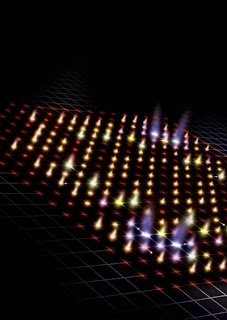An international research group led by scientists from the University of Bristol has developed a new approach to quantum computing that could soon be used to perform complex calculations that cannot be done by today's computers.
Scientists from Bristol's Centre for Quantum Photonics have developed a silicon chip that could be used to perform complex calculations and simulations using quantum particles in the near future. The researchers believe that their device represents a new route to a quantum computer – a powerful type of computer that uses quantum bits (qubits) rather than the conventional bits used in today's computers.
Unlike conventional bits or transistors, which can be in one of only two states at any one time (1 or 0), a qubit can be in several states at the same time and can therefore be used to hold and process a much larger amount of information at a greater rate.
"Our technique could improve our understanding of such important processes and help, for example, in the development of more efficient solar cells," adds Prof O'Brien. Other applications include the development of ultra-fast and efficient search engines, designing high-tech materials and new pharmaceuticals.
The leap from using one photon to two photons is not trivial because the two particles need to be identical in every way and because of the way these particles interfere, or interact, with each other. There is no direct analogue of this interaction outside of quantum physics.
"Now that we can directly realize and observe two-photon quantum walks, the move to a three-photon, or multi-photon, device is relatively straightforward, but the results will be just as exciting" says Prof O'Brien. "Each time we add a photon, the complexity of the problem we are able to solve increases exponentially, so if a one-photon quantum walk has 10 outcomes, a two-photon system can give 100 outcomes and a three-photon system 1000 solutions and so on."
The group, which includes researchers from Tohoku University, Japan, the Weizmann Institute in Israel and the University of Twente in the Netherlands, now plans to use the chip to perform quantum mechanical simulations. The researchers are also planning to increase the complexity of their experiment not only by adding more photons but also by using larger circuits. ###
Contact: Aliya Mughal Aliya.Mughal@bristol.ac.uk WEB: University of Bristol















1 comment:
Quantum field theory and qubit science are closing in on ultimate scale quantum mechanical simulation algorythms. Research progress depends on the data density of the atomic topological function used to analyze the structural details of electrons, waves, energy, and force fields. Recent advancements in quantum science have produced the picoyoctometric, 3D, interactive video atomic model imaging function, in terms of chronons and spacons for exact, quantized, relativistic animation. This format returns clear numerical data for a full spectrum of variables. The atom's RQT (relative quantum topological) data point imaging function is built by combination of the relativistic Einstein-Lorenz transform functions for time, mass, and energy with the workon quantized electromagnetic wave equations for frequency and wavelength.
The atom labeled psi (Z) pulsates at the frequency {Nhu=e/h} by cycles of {e=m(c^2)} transformation of nuclear surface mass to forcons with joule values, followed by nuclear force absorption. This radiation process is limited only by spacetime boundaries of {Gravity-Time}, where gravity is the force binding space to psi, forming the GT integral atomic wavefunction. The expression is defined as the series expansion differential of nuclear output rates with quantum symmetry numbers assigned along the progression to give topology to the solutions.
Next, the correlation function for the manifold of internal heat capacity energy particle 3D functions is extracted by rearranging the total internal momentum function to the photon gain rule and integrating it for GT limits. This produces a series of 26 topological waveparticle functions of the five classes; {+Positron, Workon, Thermon, -Electromagneton, Magnemedon}, each the 3D data image of a type of energy intermedon of the 5/2 kT J internal energy cloud, accounting for all of them.
Those 26 energy data values intersect the sizes of the fundamental physical constants: h, h-bar, delta, nuclear magneton, beta magneton, k (series). They quantize atomic dynamics by acting as fulcrum particles. The result is the exact picoyoctometric, 3D, interactive video atomic model data point imaging function, responsive to software application keyboard input of virtual photon gain events by relativistic, quantized shifts of electron, force, and energy field states and positions. This system also gives a new equation for the magnetic flux variable B, which appears as a waveparticle of changeable frequency. Molecular modeling and chip design engineering application software developer features for programming flow are built-in.
Images of the h-bar magnetic energy waveparticle of ~175 picoyoctometers are available online at http://www.symmecon.com with the complete RQT atomic modeling manual titled The Crystalon Door, copyright TXu1-266-788. TCD conforms to the unopposed motion of disclosure in U.S. District (NM) Court of 04/02/2001 titled The Solution to the Equation of Schrodinger.
Post a Comment